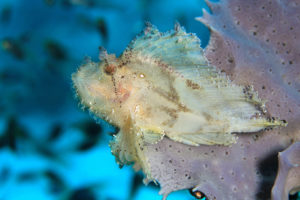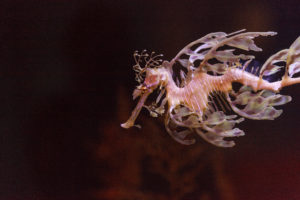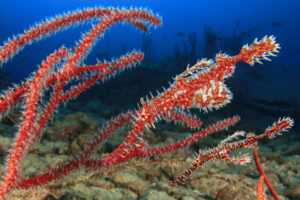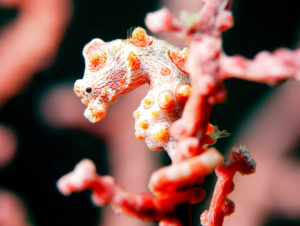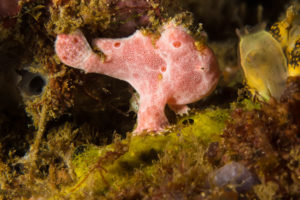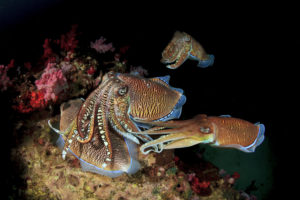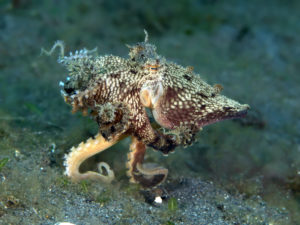Camouflage is one of the animal kingdoms’ most effective survival mechanisms. Prey can dodge predators, and predators can trick prey into coming too close. Creatures that are gifted in the art of disguise, whether through behavior or physical appearance, can seem invisible to even the keenest of eyes. While there are many camouflage experts in the oceans, here are our picks for the top eight underwater masters of camouflage.
 Leaf scorpionfish
Leaf scorpionfish
The leaf scorpionfish has not only camouflaged external looks, but is also a talented movement copycat. Much as its name implies, the leaf scorpionfish looks almost entirely like a leaf, and can also act like one. It sways side-to-side gently as if in underwater currents, mimicking the movements of a dead leaf. Although this fish is a complete master of disguise, don’t assume it’s defenseless. This critter is actually a powerful predator with its deadly strike.
 Leafy seadragon
Leafy seadragon
Next up we have a diver favorite, especially among photographers. The leafy seadragon is mesmerizing underwater — if you’re lucky enough to spot one. This creature, endemic to South Australia, resembles the seaweed and kelp in these waters. It, like the leaf scorpionfish, can mimic the natural movements of leafy greenery by drifting and swaying with ocean currents and surge. Being a relative of the seahorse, the males carry their eggs underneath their tails, giving birth to the young.
 Ghost pipefish
Ghost pipefish
A must-include on the masters of camouflage list is the ghost pipefish. Even more specifically, we must note the robust ghost pipefish. These weird, yet adorable, creatures swim and hover vertically, and catch prey from underneath. Some ghost pipefish vary in color and feature spikes around their bodies to help them blend into nearby crinoids. Others, like the robust ghost pipefish, resemble blades of sea grass and can also vary in color. Their talents of disguise enable them to be sneaky predators and to evade predators themselves.
 Stonefish
Stonefish
Stonefish inhabit rocky coral in and around the Indo-Pacific. Divers often have difficulty spotting them due to their uncanny resemblance to the surrounding coral and rocks where they’re camped. A diver unlucky enough to receive a sting by one of their many spines can expect extreme pain, making stonefish a very dangerous hide and seek player. Their venom is among the world’s most toxic, although nobody has yet died from a sting.
 Pygmy seahorse
Pygmy seahorse
The adorable yet elusive pygmy seahorse certainly belongs on our list of camouflage masters. Their miniscule size and uncanny camouflage combined such that these little critters remained undiscovered until 1969. Scientists accidentally discovered the first while examining a sea fan on which a pygmy was perched. These creatures look exactly like their sea fans, and the very largest only grow to about one inch long (2.7 cm). If your dive guide spots one, thank him or her immensely, as it’s a difficult task even when you know that they are there. You can find pygmy seahorses anywhere between 33 and 130 feet (10 to 40 m) deep. They mainly inhabit the waters of the Coral Triangle, from far southern tropical Japan to the Philippines.
 Frogfish
Frogfish
Some would say that frogfish are among the ocean’s ugliest creatures (not many divers though), and they’re certainly among the ocean’s weirdest. The two species with a space reserved on our best-camouflaged list are the giant frogfish and hairy frogfish. Once fully mature, these fish are formidable predators, not solely because they attract prey with a fake lure, but also because they are blend exceptionally well into their surroundings. The giant frogfish often looks like coral and rock covered in algae, and the hairy frogfish closely resembles a fluffy ball of algae. Their superior camouflage helps them both hide and hunt at the same time, all without moving an inch.
 Cuttlefish
Cuttlefish
Another notable critter with a master’s degree in camouflage is the cute and quirky cuttlefish. It is a cephalopod, closely related to octopus and squid, and it can change shape, color and texture to elude predators. It can also mimic its surroundings in an instant, blending in with algae, coral, rock or even sand, appearing almost invisible. This is all thanks to its skin, which contains 10 million color cells.
Mimic octopus
Finally, we arrive at the true champion, which deserves to remain on the camouflage throne for the foreseeable future: the mimic octopus. Like cuttlefish, octopus are cephalopods that can change color, shape and texture in an instant to easily blend into their surroundings. This allows them to successfully hide from predators, as well as trick their unsuspecting prey. The shape-shifting mimic octopus, like its name suggests, mimics a variety of other sea creatures to trick, confuse and escape predators. These animals can impersonate lionfish by stretching their arms upward and outwards to mimic poisonous spines. They can also copy the physical body and swimming motions of a flat, venomous sole to ward off predators or a poisonous sea snake by changing the colors and patterns on their arms and mimicking the snake’s movement in the sand.


